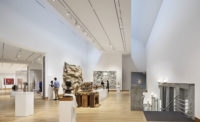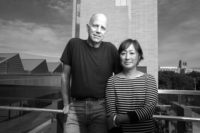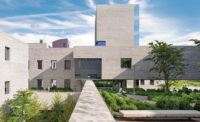In planning the expansion of its arrival buildings, the Frederik Meijer Gardens & Sculpture Park had certain attributes at the top of its list. For one, the architecture needed to be discreet—not an “object” building. Yet the new welcome center and ancillary structures should have a strong presence for the growing number of visitors to the park’s 158 landscaped acres in the northwest part of Grand Rapids.
The public botanical garden, art museum, and outdoor sculpture park was founded in 1995 by Frederik Meijer, whose success with a shopping chain enabled him to both collect sculpture and pursue philanthropy. The horticultural emphasis owed much to Meijer’s wife, Lena, and the initial leadership of the West Michigan Horticultural Society. Beginning with the five-story-high tropical-plant conservatory, the institution added an eight-acre Japanese garden, various parks for children, a nature trail, and miles of luxuriant glades where about 200 sculptures (by Auguste Rodin, Henry Moore, Alexander Calder, Jonathan Borofsky, and others) were carefully ensconced.
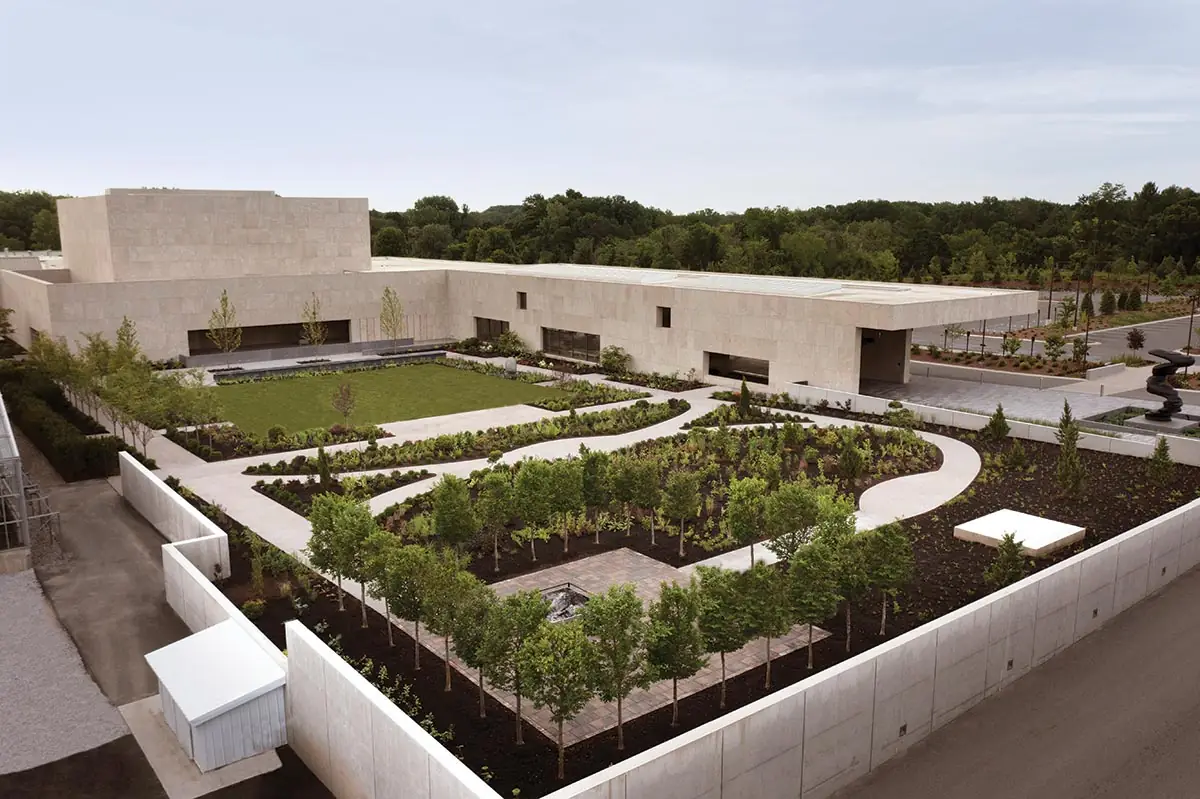
Leaving the picnic area, visitors find the entrance portico and the center itself, both of which enclose the English Perennial Garden. Photo courtesy Frederik Meijer Gardens & Sculpture Park, click to enlarge.
The original 1995 building for ticketing, orientation, a library, café, galleries, and offices was designed by the local firm of Cox Medendorp Olson Architects and added on to by Progressive | AE (associate architects on the current expansion). But the ensemble couldn’t accommodate comfortably some 780,000 people drawn annually to the gardens. Even in early spring, the throngs flocking to the tropical conservatory to see the annual exhibition of 7,000 butterflies flitting among palms and bamboo trees created its own crowd-control problem.
By 2015, the institution, led by president and CEO David Hooker, knew it was time to expand. The existing assortment of low-rise structures with curved fieldstone walls lacked a strong identity. This is where the New York firm of Tod Williams Billie Tsien Architects | Partners (TWBTA) came in. Chosen from a list of those submitting RFQs, TWBTA’s reputation for subtle, daylight-filled, volumetric structures with interlocking spaces, and its emphasis on solid materials such as concrete, masonry, and stone, with crisply crafted details, carried the day.
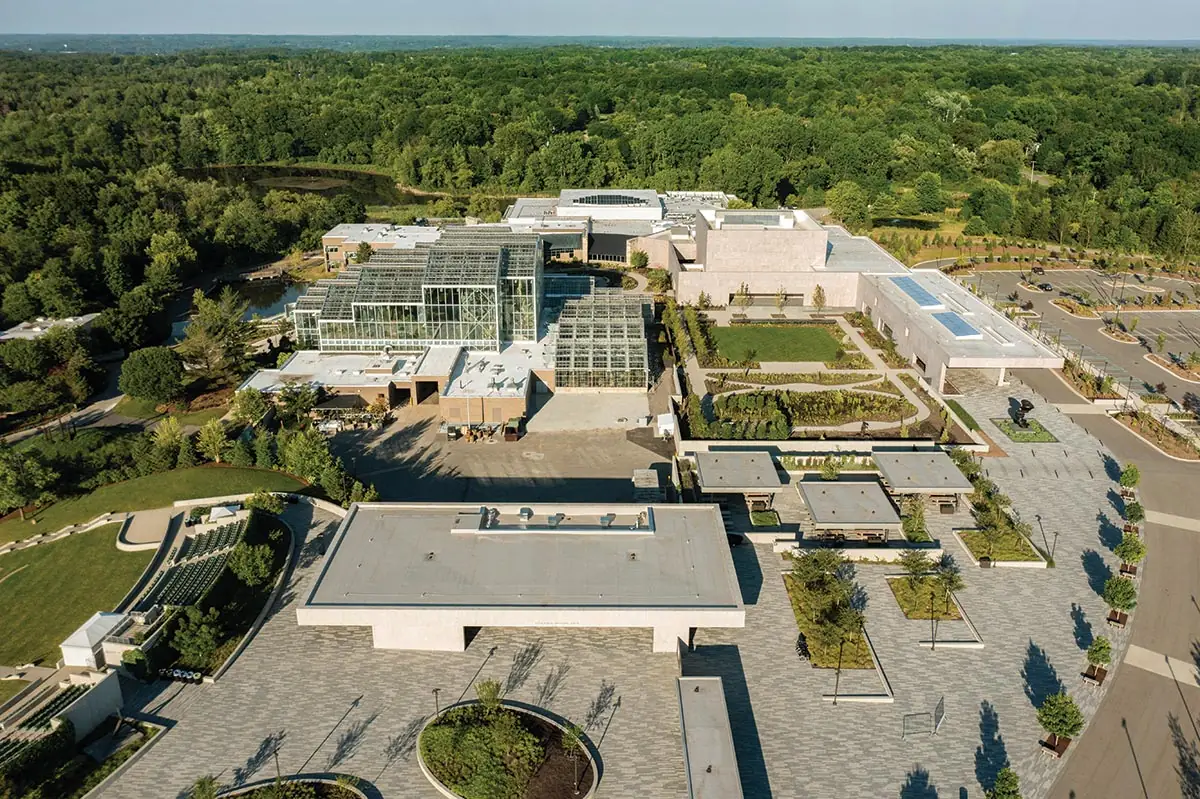
TWBTA’s new structures are added onto existing buildings, including the tropical conservatory. Photo courtesy Frederik Meijer Gardens & Sculpture Park
Hooker and his team asked Williams and Tsien to come up with a site plan that would give more order to the parking and arrival process and create a new 69,000-square-foot welcome center. Also needed was a structure for concession stands serving the renovated and expanded 1,900-seat amphitheater, plus a transportation center and outdoor picnic shelters, all for a total cost of $115 million.
“We thought an orthogonal plan would better organize the whole experience,” says Tsien. The concrete-framed, Minnesota-granite-clad center consists of a large square block, with its northeast corner attached to the original arrival pavilion. On the southwest corner, a rectilinear glassed-in wing extends past the parking lots toward the amphitheater. In this long, enclosed porchlike hall, where visitors may gather in inclement weather, large planters are suspended from the ceiling, whose aluminum baffles are printed to look like teak. Along the north wall, the public encounters the new variegated English Perennial Garden created by Julie Moir Messervy Design Studio of Vermont.
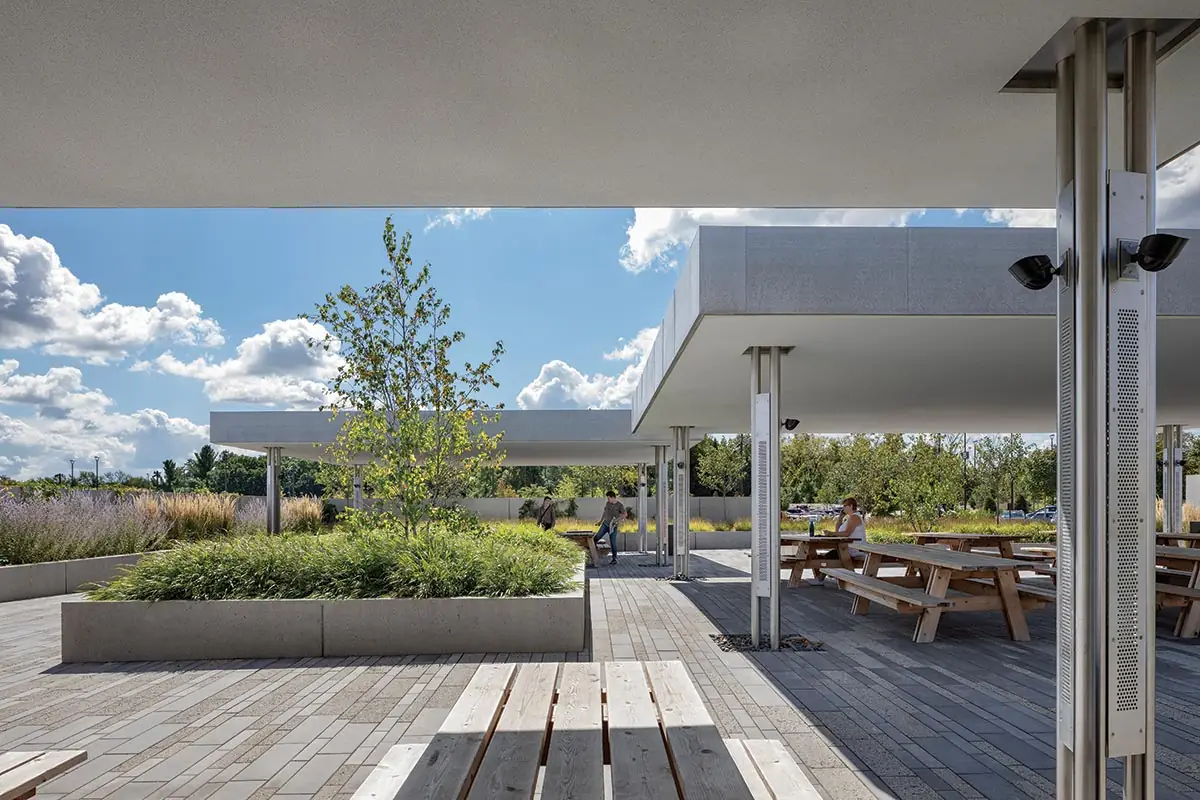
The picnic pavilions are near the English garden and the entry portico. Photo © Michael Moran
The plan of the rest of the spacious center has intriguing moments: for example, when you enter, you find the ticketing area and lounge are in the back. Previously, in the smaller building, ticketing occurred at the exact point of entry and created bottlenecks. Now visitors drop off their coats and paraphernalia before heading to the rear to purchase tickets or wait for friends and family. This airy corner room, glassed in on the south and east to visually bring the landscape inside, features a Tsien-designed felt tapestry emulating the Michigan sky. The fabric wraps around the top of the window walls, forming a dark backdrop against which Circus Acrobats, a white George Segal sculpture suspended from the ceiling, stands out. Beneath the acrobats, Tsien created a carpet evoking a field of clover.
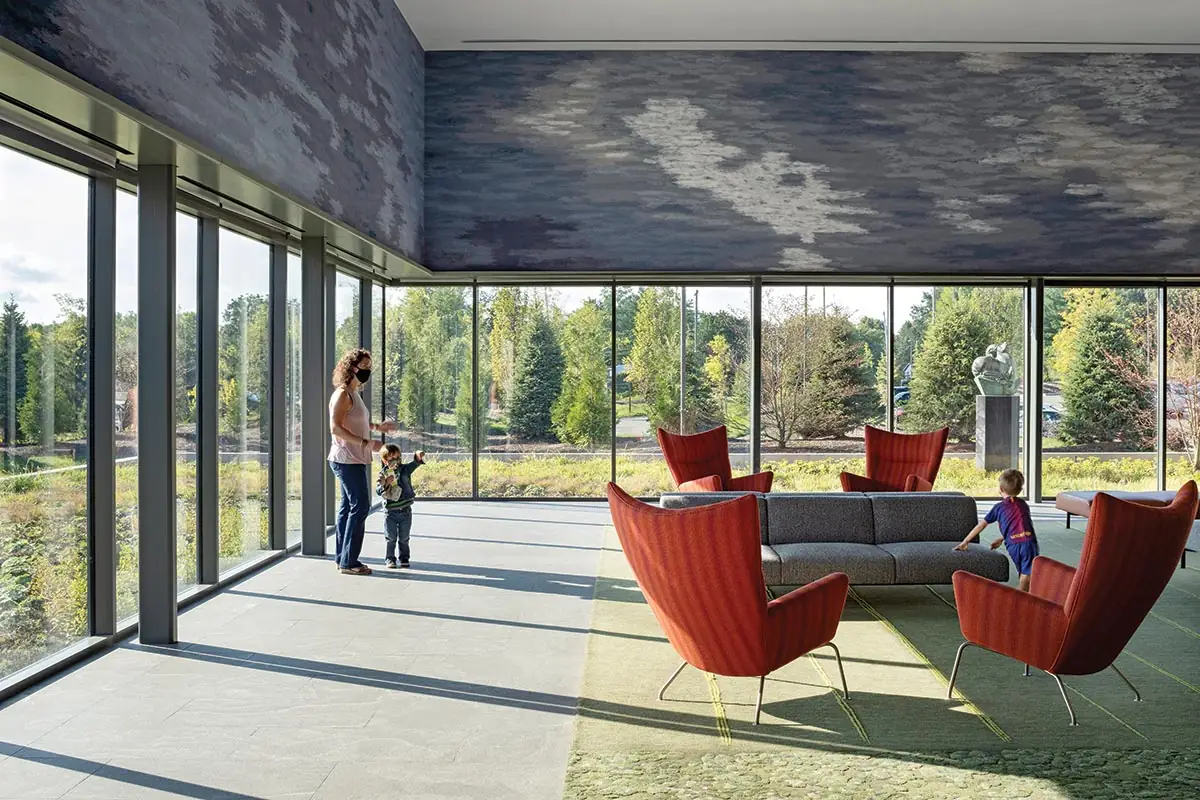
The ticketing center, on the southeast corner, opens out to views of the landscape. Photo © Michael Moran
Marking the centerpiece of the building is a monumental hall, 86 feet square, named the “Garden Pavilion.” Here, three vaulted skylit chambers illuminate the room, their shapes evocative of the folded planes of the geometric lightbox sailing over the lobby at the Barnes Foundation in Philadelphia. “We wanted a spectacular space,” says Hooker, “and when we visited the Barnes, we saw that Tod and Billie were experts in using light to make dramatic and ever-changing experience.”
In this pavilion, the beams of sunlight shift in intensity throughout the day, a move that was “inspired by the way the sun comes into the Pantheon,” says Williams. The architects built models to test the light’s movement; in the Garden Pavilion the rays rake over the sculptural bas-reliefs on the walls created by Spanish artist Jaume Plensa. The site-specific artwork was conceived, according to Hooker, to celebrate the institutional mission of combining art and architecture. Plensa was a curatorial favorite: he created an outdoor sculptural group for the gardens and had a show of his work at the galleries in 2008.
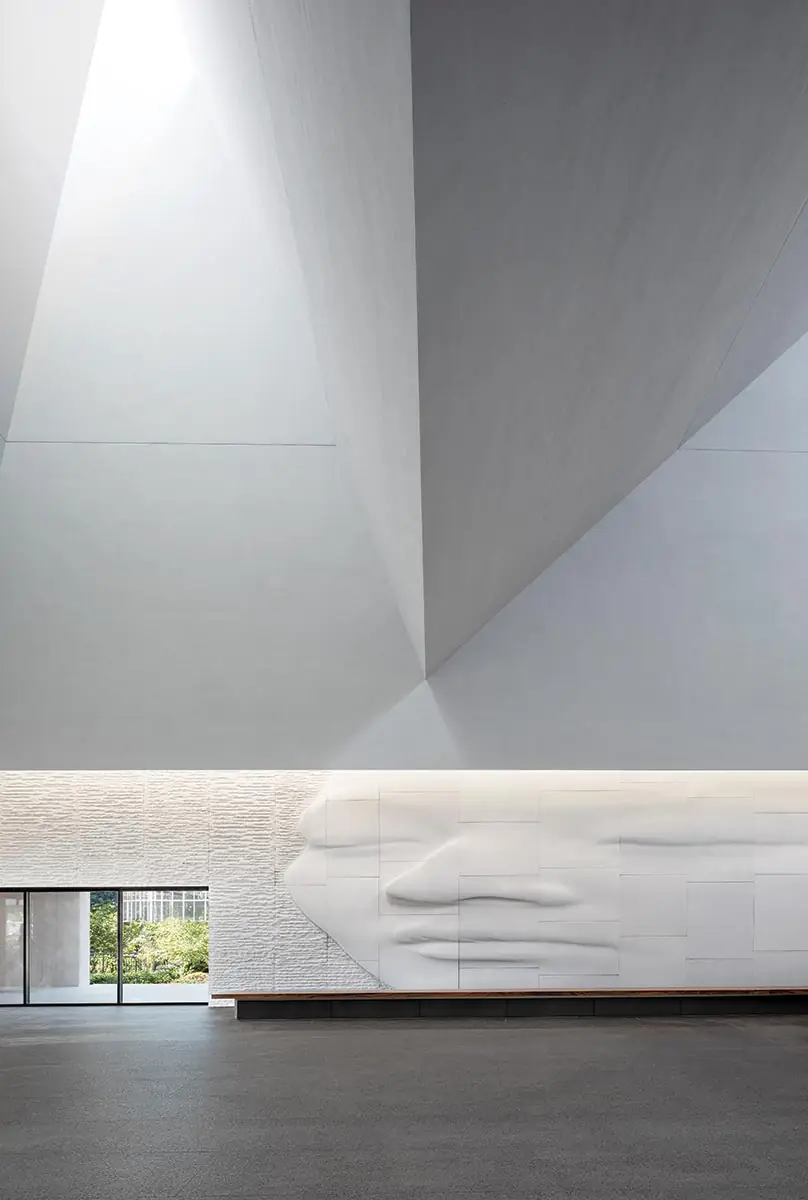
In the Garden Pavilion, daylight from the vaulted chambers illuminates Jaume Plensa’s bas-relief Utopia. Photo © Michael Moran
Named Utopia, Plensa’s four 19-by-86-foot segmented white marble bas-reliefs depict faces of various women from around the world, horizontally elongated. The marble, quarried in Vietnam, has no veins or changes in color. The heavy blocks were transported to Plensa’s Barcelona workshop, where he and his assistants, aided by computers and hand tools, produced the panels. The 400 pieces had to be carefully installed on the walls at Meijer so that gaps were no wider than 2 millimeters. In addition, the panels were intricately integrated into the steel framing of the horizontal members supporting the vaulted skylights.
The weight of the marble panels required TWBTA to beef up the structure with large concrete footings. Adding to the complexity was the HVAC: half of the plaster-finished vaulted ceilings conceal radiant heating and cooling panels, while the other half hide acoustical panels. (Radiant heating and cooling is installed as well beneath the floor’s stone paving.)
The result is an ample and crowd-pleasing space, ideal for receptions. More often it functions as a throughway for visitors proceeding to the existing curvilinear stone-walled building, where the galleries, shop, offices, and services are located. The entrance to the tropical conservatory is just beyond.
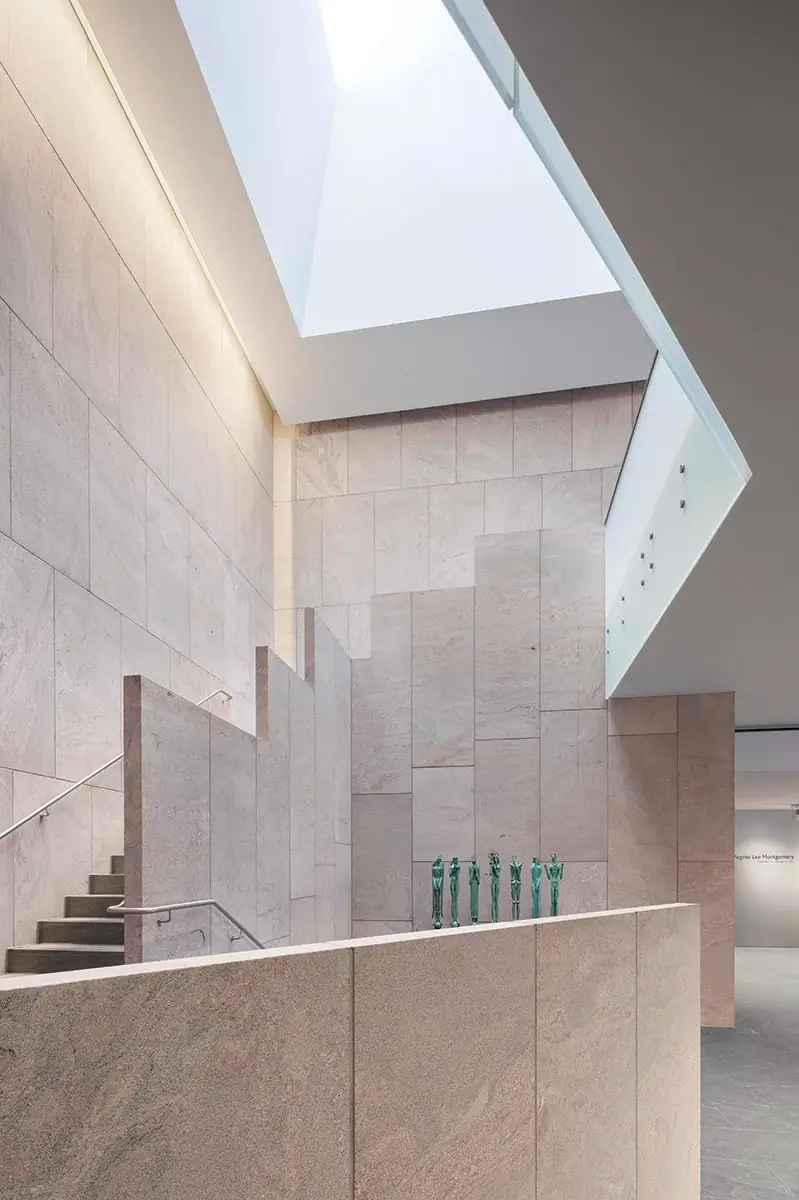
Granite planes give the skylit stair (opposite) a sculptural presence. Photo © Michael Moran
On the northeast corner of the Garden Pavilion, TWBTA created a dramatic stairwell—its own three-dimensional sculpture—with stepped vertical planes of granite under a skylight. Descending the stair to the lower level in the expansion, visitors find a library, lounge, and the volunteers’ room. These spaces receive light through a landscaped courtyard, a feature evocative of the lower-level courtyards at the Barnes and at TWBTA’s Andlinger Center at Princeton University.
As with the Princeton science building, Williams and Tsien had to integrate a new structure into an already existing physical setting and tie it all together with strong organization. To make sure everything turned out well during the pandemic, the project manager, Elisa Testa, left New York in July 2020 to live on-site for six months. The result is an architecture that is discreet, but not a mute, background building. It skillfully showcases the art on display and relates to the natural setting, yet demonstrates Williams and Tsien’s flair for the tectonic response: once again, craft, detailing, and materials converge to exploit space and light.
Click plan to enlarge
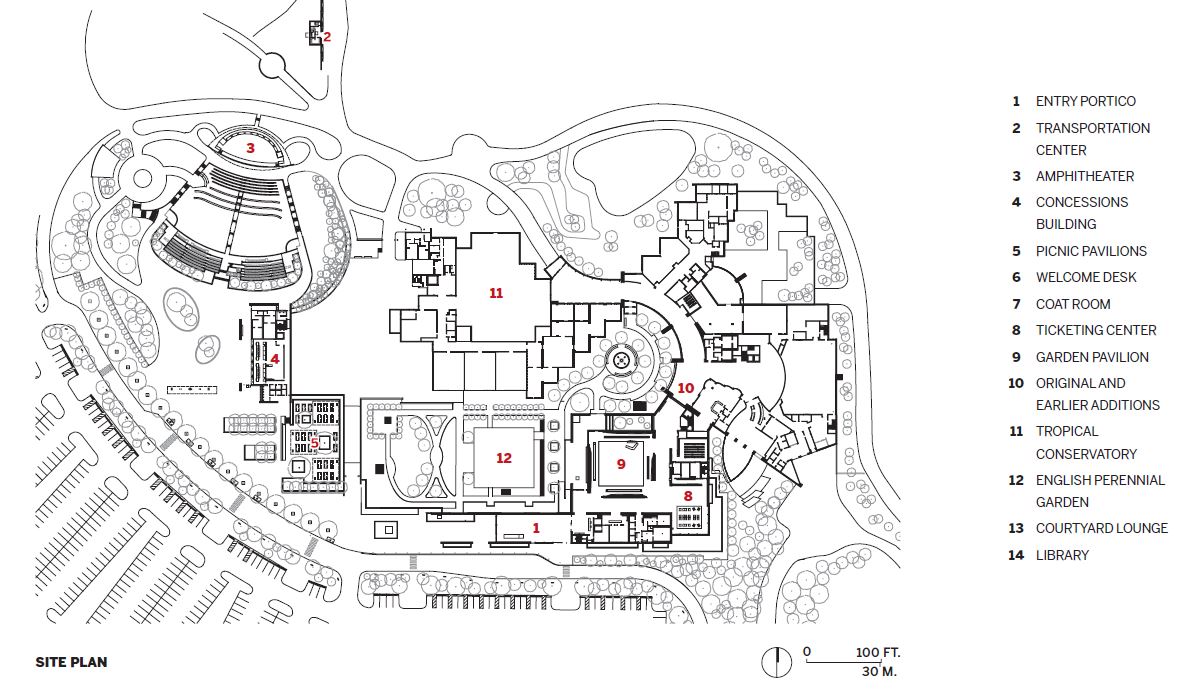
Click plan to enlarge
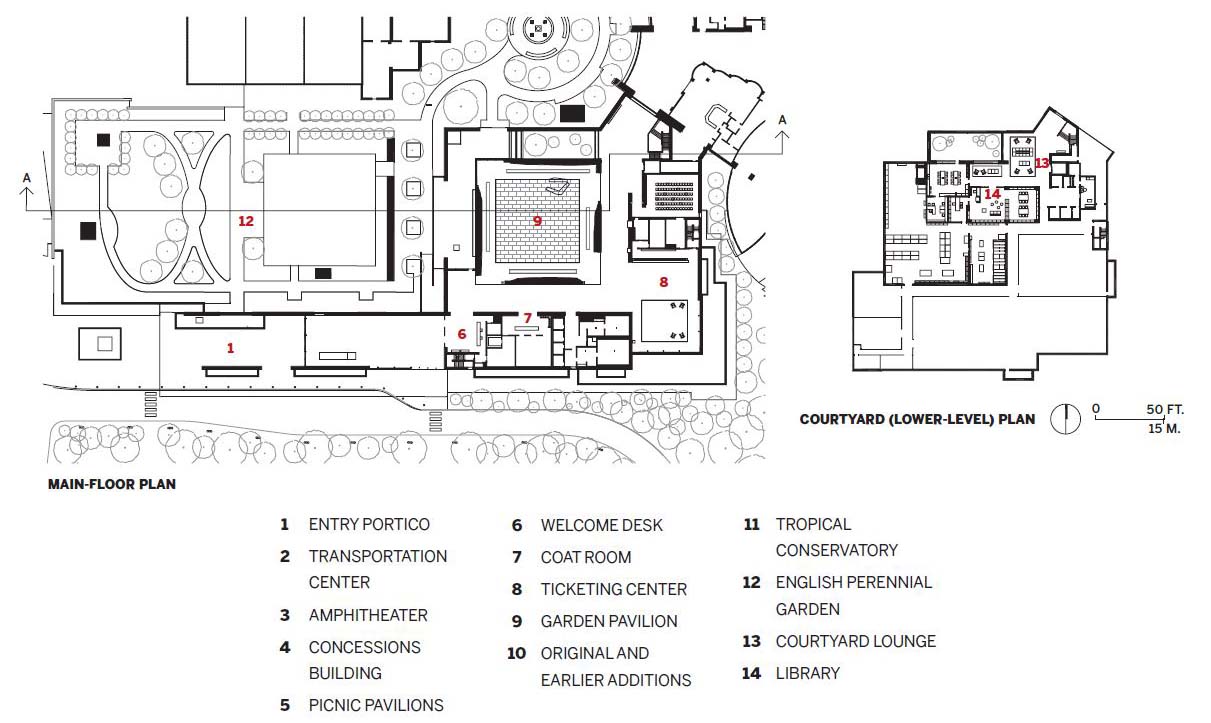
Click section to enlarge

Credits
Architect:
Tod Williams Billie Tsien Architects | Partners — Tod Williams, Billie Tsien, lead designers; Elisa Testa, project manager; Johnny Cho, project architect
Associate Architect:
Progressive | AE
Engineer:
Progressive | AE (structural, civil, m/e/p/fp)
General Contractor:
Owen-Ames-Kimball
Consultants:
Fisher Marantz Stone Partners (lighting); Eligator Acoustic Associates (acoustical); Catalyst Partners (sustainability)
Client:
David Hooker, president and CEO, Frederik Meijer Gardens & Sculpture Park
Size:
93,600 square feet (total), including welcome center, transportation center, concession building, picnic pavilions
Cost:
$115 million (total project); $73 million (construction)
Completion Date:
November 2021
Sources
Granite:
Coldspring
Metal/Glass Curtain Wall:
Architectural Glass and Metals
Cabinets, Paneling, Doors:
Grand Valley Wood Products
Floor and Wall Tile:
Daltile
Office Furniture:
Steelcase, Custer
Elevators:
Canton Elevator
Skylights:
Skyline Sky-lites
Glass:
Viracon



